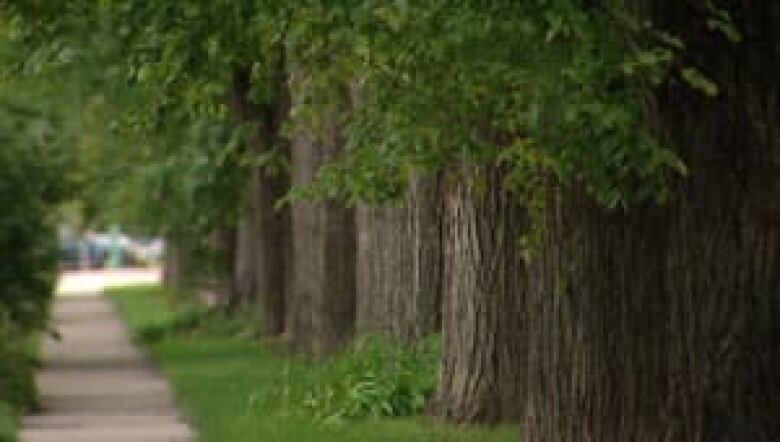Dutch elm disease battle in Winnipeg gets boost from U of W students
Disease seems to be getting resurgence after cuts to city's forestry branch budget

Winnipeg researchers are digging beneath the bark of trees in Wolseley and River Heights in search of answers that might help the citycontain the spread of Dutch elm disease.
City crews can't seem to keep pace with the spread on their own this summer, University of Winnipeg entomologist Richard Westwood said.
"The city's program has been really successful at keeping the rate low but we seem to have a bit of resurgence," he said.
"The city forestry branch budget has been cut back quite a bit by city council over the last few years, so they're kind of resource-tight right now. There are quite a few trees out there."
There were more than 200,000 adult elm trees growing throughout Winnipeg as of the spring of 2015 the largest such population in North America and about 5,000 were being removed on average each year, the city's foresterMartha Barwinsky previously told CBC News.
The city's rapid-removal project targets Dutch elm trees already infected or at risk of spreading the disease, andmost removal is done in the fall and winter months. There were nearly 6,500 elms marked for death at the beginning of the 2016-17 removal season, and 1,300 had still yet to be removed by the end of May, according to the city.
Westwood said the city is interested in finding new ways to improve its ability to combat the tree sickness, which is where his team comes in.
Dutch elm disease spreads on the backs of elm bark beetles that carry a harmful fungus. They typically attack and lay eggs in elm trees in the spring. Thelarvae eventually hatch and mature through summer, before another generation of beetles bursts forth in the fall. That new population flies to new, healthy trees and infects them, Westwood said.
Research out of theUniversity of Manitobahas shown certain trees tend to produce bigger beetle populations than others.
If there was a better way to identify and remove those trees during the summer months, instead of waiting for winter,in theory it could lead to lower infection ratesin communities such as River Heights and Wolseley, Westwood said.

The challenge is in knowing what symptoms to look for on the outside of trees that indicate a burgeoning beetle community within, Westwood said.
"That's our job to find out," Westwood said.
To do that, he and a team of students are cataloging the various symptoms they find, hacking bark away, counting beetle numbers and the intricate patterns they leavein hopes of learning more.
"And then we're going to try and come up with a formula and a process that will allow the city to try to identify these trees early on and get them out," he said.
If their work proves successful this summer, Westwood says they may return next year, to the delight of many in Wolseley and River Heights.
"Some people have been just great and they come out and they say, 'This is great, great to see somebody working [on this],'" he said.
"They really love their trees. I mean, we've talked to a number of people, they have a personal relationship with a tree on their property or on their boulevard and they're sad to see it go.
But they're really excited that if we can get the disease pressure down, that would save their other trees."
With files from Laurie Hoogstraten, Jacques Marcoux












_(720p).jpg)


 OFFICIAL HD MUSIC VIDEO.jpg)
.jpg)



























































































